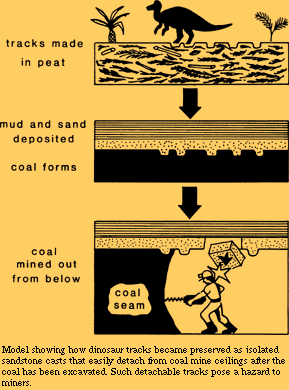

Mining is a hazardous profession. Every mining community has known tragic incidents of death, injury, or disease resulting from explosions, cave-ins, and exposure to dust and bad air. In the mining communities of the western United States, anecdotes and apocryphal stories circulate about dinosaur tracks that fall out of mine ceilings. Given that such large sandstone casts can weigh hundreds of pounds, they clearly pose a threat to life and limb. Anecdotal as these stories may be, they do contain some truth. Most tracks in the roofs of coal mines represent footprint impressions in the peaty coal that were later filled in by sand. In some cases the sand only partly filled the tracks before finer-grained mud and silt accumulated to produce the overlying layer. This then created a sandstone pocket or protrusion that could easily detach from the overlying layer. Miners routinely bolted these protrusions to the ceiling to prevent them from dislodging. Although we know of no documented examples of tracks that fell and killed miners, we do know of a fatality caused by a dinosaur track. In March of 1969 a miner working near Hayden, Colorado, ran to stop a coal car that began to roll from him. In doing so he struck his head on one of the many tracks that protrude 3-4 inches below roof level. Although he remained conscious and was able to make his way home, he sustained a fatal spinal injury and died ten days later in a Denver hospital. In the book Bones for Barnum Brown, Roland T. Bird of the American Museum of Natural History described the hazards of subterranean fossil hunting. In his judgement, excavations of large trackways that he undertook in mines have been relatively safe compared to what he regards as his own foolhardy excavations of plant fossils in decidedly unsafe locations. In earlier times, as miners excavated along coal seams they removed roof supports, thus allowing the roof to collapse under overburden pressures. It was in these marginal areas that Bird reported collecting some prize plant fossils. Although adventurous, Bird was normally a cautious man, but in this case his foolhardy quest for fossils could have cost him his life. |